On This Day 157 Years Ago: What Happened in Payahüünadü Then, What's Happening Now, and How It's All Interconnected
Photo by of so-called Lake Sabrina in Payahüünadü by Steve Wiesner on Unsplash
Not too long ago, on July 11, 1863 (yesterday about 157 years ago), 1,000 Paiutes from Payahüünadü (what settlers/colonizers consider the Owens Valley/Bishop area), were forced from their homelands to march 250 miles to Fort Tejon, where now exists the Tejon Reservation.
As Jolie Varela from Indigenous Women Hike shares on a recent Instagram post, “They were lured for an Independence Day celebration with the promise of food and land. They were held against their will until July 11th when they were forced to march 250 miles to Fort Tejon. “
It exists as one of many immeasurably traumatic and evil events of our settler-colonial history -- but time is non-linear, right? So, what HAS happened -- IS happening.
The intense, urgent, and necessary swirl of Black Lives Matter uprisings, the actions of resistance taking place, as evident in the recent call from NDN Collective for the indefinite closure of Mount Rushmore National Monument, and for the sacred Paha Sapa, or the so-called Black Hills, to be returned to the Lakota people, all indicate that the fight for Black liberation and Indigenous sovereignty lives on. Even more, it all indicates that the current order as we know it is shifting.
It is extremely important to integrate the lessons we are learning from the true history we are digging up with the events we are experiencing at present. Spend some time every day. Make it a ritual.
In a presentation delivered on March 1, 2018 at UC Berkeley, William J. Bauer, citizen of Round Valley Indian Reservation, and author of California Through Native Eyes, Bauer discusses his research methods and how his work is mostly done through indigenous oral histories because “...too often Americans or non-Indian people wrote most of the sources that were found in the archives.” He points out how non-Indigenous sources often conflict with Indigenous sources.
“And this prompted a question,” Bauer said to the group of people gathered to hear him speak, “I ask, ‘How would a history of California read if we only used California Indian sources and methods to interpret and tell that past?’”
A question we must ask ourselves about all of the stolen land in which we exist and visit within Turtle Island.
We must remember that revolution and transformation are not only happening externally, but internally. How are you integrating the past, present, and future into your being? How are you transfusing your life, body, and being with the intensity of the times? As you consider your position in the world, your particular family’s legacy and lineage, who do you want to be? As you change and transform, what will you cultivate, grow, and nourish in place of your shedding layers?



